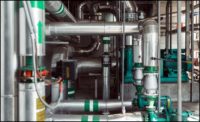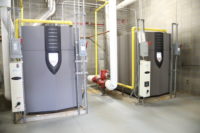The opening of a new school is an exciting time. Seeing reactions from students and educators the first time they walk through the door and watching as community members celebrate their investment in education fuels my passion for designing K-12 education environments that inspire students to excel. I’m honored to spend my days designing mechanical system solutions that cater to the everyday needs of young learners as they prepare for life after graduation.
One of my most recent and memorable projects is Salem Woods Elementary School in Monroe, Washington. This project is a prime example of how DLR Group’s integrated design team challenged the status quo and collectively arrived at a solution that enhances the educational environment, optimizes occupant comfort, and reduces energy consumption.
The original school was built in 1980. An addition was implemented in 1987, and a renovation was completed in 1999. Monroe School District 103, located 30 miles northeast of Seattle, opted to replace its outdated facility with a new two-story structure that opened in August 2018. The design for the 550-student school centers around six pods that group students together to encourage collaboration and community building. Shared activity areas within the pods support small and large group projects and hands-on learning — all spaces you’d expect to see in a school today.
A Hybrid System
Designing to a strict budget of $16.2 million, DLR Group’s team identified an opportunity to save roughly $500,000 by reducing the floor-to-floor height on both stories from 14 feet to 13 feet, 6 inches. This decision allocated dollars from the structure itself to fund a hybrid HVAC system that consisted of a heat recovery air-to-water chiller (HRC) with backup boilers for extreme cold days below 30ºF. The HRC serves chilled and heating water coils in three 100 percent outside air units (OSA) as well as one mixed-air AHU and eight fan coil units. This solution had no visible impact on the learning environment because the inches were eliminated from space above the ceiling, requiring system installers to precisely follow plans and measurements to ensure the piping and ductwork were properly installed in the allocated space above the ceiling.The fan coil units, which serve the shared activity learning areas within the pods, are fully decoupled systems that cover only the sensible load of the spaces they serve and power off when not carrying load. The 100 percent OSA units act as dedicated outside air systems for these fan coils, providing ventilation and bringing fresh air into the shared learning areas. Classrooms are heated by hydronic radiant heaters below the windows served by the HRC and backup boiler system.
> FIGURE 1. Displacement Ventilation Concept Diagram
This solution, which enhances the indoor environment for learners, is supported by research studies that link increased IAQ to increased performance of students and a reduction in the transmission of infections. A few study examples include “Indoor Environment in Schools — Pupils’ Health and Performance in Regard to CO2 Concentrations” by Myhrvold, A.N., E. Olsen, and O. Lauridsen 1996; and “Role of Ventilation in Airborne Transmission of Infectious Agents in the Built Environment — A Multidisciplinary Systematic Review” by Li, Y., M. Leung, et all 2007.
Washington is the perfect climate to implement this solution. The Pacific Northwest is known for its eternal shoulder months, where temperatures vary throughout much of the year from 40°-60°. This swing causes building systems to switch between heating and cooling throughout the day; however, by utilizing this system, the school can easily be cooled or heated simultaneously at partial load, which equates to potentially 20 percent energy savings.
Displacement Ventilation
Classrooms and learning environments at Salem Woods Elementary School experience high occupancy throughout the school day and are ideal for displacement ventilation. As a stratified system, displacement ventilation provides low air at low velocity, which allows air to rise over occupants and heat to be pulled from the ceiling. The stratified nature of a displacement ventilation system allows for an increased supply air temperature and helps to reduce the energy consumption of the building. Other advantages are increased indoor air quality and increased user comfort, both contributors to student achievement as noted in the study titled “The Effects of Classroom Air Temperature and Outdoor Air Supply Rate on the Performance of School Work by Children,” by Wargocki, Wyon, Matysiak, and Irgens.
Each classroom is outfitted with three displacement diffusers along one wall and hydronic finned tube radiant heaters beneath the windows to cover the heating load and minimize heat loss. To properly displace existing air in the space, a 3-foot area around the diffusers must remain unobstructed. Prior to opening the school, DLR Group reps met with facilities personnel and school administrators to properly train the staff on the importance of keeping the diffusers unobstructed. During heating mode, the finned tube radiators are decoupled from the ventilation system, which results in a significant reduction in fan energy in the winter, when only the minimum ventilation to the spaces is required. This allows the finned tubes to cover the heat load of the space, which will save nearly 80 percent of the fan horsepower during heating mode.
> FIGURE 2. Displacement Ventilation Typical Classroom Diagram
We incorporated a different system in the administration area of the school to adequately heat and cool this space year-round. The AHU serves the administration area via a standard overhead mixed air distribution system, which equals about 20 percent of the entire school’s floor area.
Heat Recovery Chiller
As I mentioned before, the Pacific Northwest climate is ideal for the application of heat recovery chillers. Many days throughout the year will require some of the building to be cooled and other portions to be heated simultaneously. The number of cooling degree days (CDD50) and heating degree days (HDD50) in Monroe above and below 50ºF is roughly 1,600 and 1,200, respectively, while the number of HDD65 below 65ºF totals roughly 5,000, making Washington an ideal climate for heat pump operation. Washington is a heating-dominated climate with mid-range temperatures; however it also requires a fair amount of cooling, which makes a heat recovery chiller a prime solution to cover both loads simultaneously.
> FIGURE 3. Displacement Ventilation Duct Diagram
Allowing the chiller to produce both heated hot water and chilled water reduces work on the compressors and allows for increased part-load efficiency. A typical natural gas system operates at roughly 92 percent efficiency; however, the heat recovery chiller, like the one installed at Salem Woods Elementary School, operates at 200-600 percent efficiency in heating mode, a significant opportunity for approximately $10,000 in annual energy cost savings for the district.
DLR Group designed the hybrid system to maximize efficiency. When the outdoor ambient conditions approach 38º, the efficiency of the heat pump decreases, and its ability to produce the design temperature of water is hindered. To counter this situation, injection boilers installed in a boiler room produce the design temperature heating water needed for the system. The injection boilers act as a primary-secondary system due to installing the main building loop pumps as part of a pump package module added to the HRC. The boilers are only designed to maintain design temperatures in the main building loop when the outside conditions are below 38º. The building automation system reads the system loop temperature, and when it swings below the design temperature, boilers are energized to produce needed heat in the main building loop.
> FIGURE 4. Heat Recovery Air to Water Chiller (HRC) System Diagram
Other modes of operation are full chiller cooling (when the chiller is operating like a traditional air-cooled chiller), full chiller heating (when the chiller is operating like a traditional air-cooled chiller but in reverse cycle heating mode), and simultaneous heating and cooling. During simultaneous heating and cooling operation, two of the three modules are dedicated to heating and cooling, respectively. The third module is dedicated as a heat recovery module, allowing rejected heat from the cooling module to supplement the heating module and vice versa as needed by the load.
Cost Savings Equals Greater Educational Opportunities
The design team discussed myriad cost-effective and environmentally responsible solutions and identified multiple opportunities for energy savings at Salem Woods Elementary School. The maintenance staff is already familiar with maintenance practices of chilled water systems, as other facilities throughout the district are currently operating standard chillers. Because of potential failure to capture all the energy savings afforded by this type of HRC system, careful coordination with the controls contractor is necessary. Now that the system is functioning to its engineered design intent, it operates and is maintained much like a standard chiller and heat pump with the added benefit of the energy savings of heat recovery operation.
The hybrid solution we agreed upon ultimately results in long-term cost savings, which benefits learners and the environment. Saving operational costs allows the district to allocate more funds to education in a building that uses fresh air to increase indoor air quality and occupant comfort.








